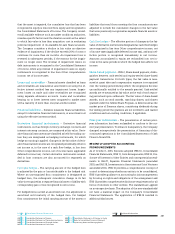Siemens 2014 Annual Report Download - page 257
Download and view the complete annual report
Please find page 257 of the 2014 Siemens annual report below. You can navigate through the pages in the report by either clicking on the pages listed below, or by using the keyword search tool below to find specific information within the annual report.
247 D. Consolidated Financial Statements 337 E. Additional Information
248 D. Consolidated Statements of Income
249 D. Consolidated Statements of Comprehensive Income
250 D. Consolidated Statements of Financial Position
251 D. Consolidated Statements of Cash Flows
252 D. Consolidated Statements of Changes in Equity
254 D. Notes to Consolidated Financial Statements
330 D. Supervisory Board and Managing Board
manufacturing leases is recognized based on the policies for
outright sales. Profit from sale and leaseback transactions is rec-
ognized immediately if significant risks and rewards of owner-
ship have passed to the buyer, the leaseback results in an
operating lease and the transaction is established at fair value.
Dividends: Dividends are recognized when the right to receive
payment is established.
Functional costs – In general, operating expenses by types
are assigned to the functions following the functional area
of the corresponding profit and cost centers. Expenses relating
to cross-functional initiatives or projects are assigned to the
respective functional costs based on an appropriate allocation
principle. Regarding amortization see NOTE OTHER INTANGIBLE
ASSETS, regarding depreciation see NOTE PROPERTY, PLANT
AND EQUIPMENT and regarding employee benefit expenses see
NOTE PERSONNEL COSTS.
Government grants – Government grants are recognized
when there is reasonable assurance that the conditions at-
tached to the grants are complied with and the grants will be
received. Grants awarded for the purchase or the production
of fixed assets (grants related to assets) are generally offset
against the acquisition or production costs of the respective
assets and reduce future depreciations accordingly. Grants
awarded for other than non-current assets (grants related to
income) are reported in the Consolidated Statements of Income
under the same functional area as the corresponding expenses.
They are recognized as income over the periods necessary
to match them on a systematic basis to the costs that are
intended to be compensated. Government grants for future
expenses are recorded as deferred income.
Product-related expenses and losses from onerous con-
tracts – Provisions for estimated costs related to product war-
ranties are recorded in line item Cost of sales at the time the
related sale is recognized, and are established on an individual
basis, except for the standard product business. The estimates
reflect historic experience of warranty costs, as well as infor-
mation regarding product failure experienced during construc-
tion, installation or testing of products. In the case of new
products, expert opinions and industry data are also taken
into consideration in estimating product warranty provisions.
Expected losses from onerous contracts are recognized in the
period when the current estimate of total contract costs
exceeds contract revenue.
Research and development costs – Costs of research activi-
ties undertaken with the prospect of gaining new scientific or
technical knowledge and understanding are expensed as
incurred.
Costs for development activities, whereby research findings are
applied to a plan or design for the production of new or sub-
stantially improved products and processes, are capitalized if
() development costs can be measured reliably, the product
or process is () technically and () commercially feasible,
() future economic benefits are probable and () Siemens
intends, and () has sufficient resources, to complete develop-
ment and to use or sell the asset. The costs capitalized include
the cost of materials, direct labour and other directly attribut-
able expenditure that serves to prepare the asset for use. Such
capitalized costs are included in line item Other intangible
assets as software and other internally generated intangible
assets. Other development costs are expensed as incurred.
Capitalized development costs are stated at cost less accumu-
lated amortization and impairment losses with an amortization
period of generally three to ten years.
Government grants for research and development activities are
offset against research and development costs. They are recog-
nized as income over the periods in which the research and
development costs incur that are to be compensated. Govern-
ment grants for future research and development costs are
recorded as deferred income.
Earnings per share – Basic earnings per share are computed
by dividing income from continuing operations, income from
discontinued operations and net income, all attributable to
ordinary shareholders of Siemens AG by the weighted average
number of shares outstanding during the year. Diluted earn-
ings per share are calculated by assuming conversion or exer
-
cise of all potentially dilutive securities and share-based pay-
ment plans.
Goodwill – Goodwill is not amortized, but instead tested for
impairment annually, as well as whenever there are events or
changes in circumstances (triggering events) which suggest
that the carrying amount may not be recoverable. Goodwill is
carried at cost less accumulated impairment losses.
The goodwill impairment test is performed at the level of a
cash- generating unit or a group of cash-generating units repre-
sented by a Division or equivalent, which is the lowest level
at which goodwill is monitored for internal management
purposes.
For the purpose of impairment testing, goodwill acquired in
a business combination is allocated to the cash-generating
unit or the group of cash-generating units that is expected to
benefit from the synergies of the business combination. If the
carrying amount of the cash-generating unit or the group of
cash-generating units, to which the goodwill is allocated, ex-
ceeds its recoverable amount, an impairment loss on goodwill
























